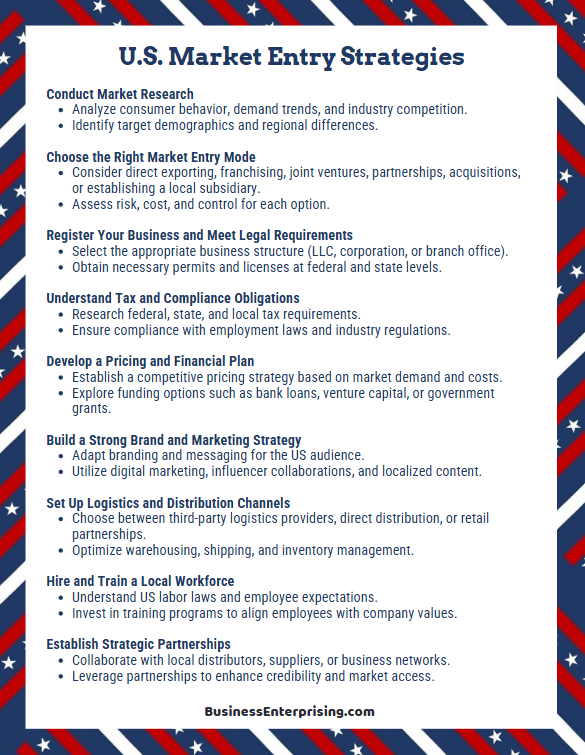
Understanding consumer behavior is crucial for success. American consumers value quality, innovation, and customer service. Additionally, they are accustomed to a wide array of choices. Therefore, differentiating your products or services becomes essential. Moreover, cultural nuances and preferences can vary significantly across regions. Conducting comprehensive market research helps you identify and cater to these differences effectively.
Navigating the legal landscape presents another set of challenges. The US operates under a complex system of federal, state, and local regulations. Consequently, compliance with business registration, tax obligations, employment laws, and industry-specific regulations requires meticulous attention. Engaging legal experts with experience in US market entry strategies can provide valuable guidance.
Competition in the US market is intense. Both established domestic companies and other international entrants vie for market share. Therefore, a thorough competitive analysis is vital. Identifying your unique value proposition and effectively communicating it to your target audience can set you apart. Additionally, leveraging local partnerships and networks can enhance your market presence and credibility.
While the US market offers abundant opportunities, it also presents distinct challenges. Developing comprehensive US market entry strategies involves understanding economic conditions, consumer behavior, legal requirements, and the competitive landscape. By addressing these factors thoughtfully, you can position your business for successful expansion into the United States.
Understanding the US Market: Key Opportunities and Challenges
Entering the U.S. market presents both significant opportunities and challenges that require careful consideration. Understanding the economic conditions, consumer behavior, legal requirements, and competitive landscape is crucial for developing effective U.S. market entry strategies.
The U.S. economy offers a diverse and dynamic environment for businesses. However, recent fluctuations, such as the U.S. dollar experiencing its worst start to a year since 2008, have introduced uncertainties. This decline, driven by concerns over unpredictable economic and foreign policies, impacts both domestic and international businesses. Additionally, the imposition of tariffs on major trading partners, including Canada, Mexico, and China, has led to economic volatility and concerns about a potential recession.
U.S. consumers are known for their diverse preferences and high purchasing power. However, there’s a growing trend toward seeking affordable options, with consumers gravitating toward low-cost retailers like Shein and Temu. This shift has challenged established brands, leading some to file for bankruptcy. Therefore, understanding these evolving consumer behaviors is essential for businesses aiming to succeed in the U.S. market.
Navigating the U.S. legal and regulatory landscape requires thorough preparation. Businesses must comply with federal, state, and local regulations, which can vary significantly. Recent policy shifts toward protectionism, including the proposal of sweeping tariffs and regulatory changes, have added complexity to the business environment. Staying informed about these changes is vital for compliance and strategic planning.
The U.S. market is highly competitive, with both domestic and international players striving for market share. Trade policies, such as tariffs and protectionist measures, have further intensified competition, affecting various industries. Businesses must develop strategies that differentiate their offerings and effectively communicate value to consumers to thrive in this environment.
Choosing the Right Market Entry Mode
Selecting the appropriate market entry mode is pivotal when considering US market entry strategies. Each method—direct exporting, franchising, joint ventures, partnerships, acquisitions, and establishing a local subsidiary—offers distinct advantages and challenges. Direct exporting involves selling products directly to US consumers or retailers from your home country. This approach minimizes investment but may limit control over distribution and customer engagement. Alternatively, franchising allows your brand to expand by granting US-based entrepreneurs the rights to operate under your name. This strategy facilitates rapid growth with reduced capital expenditure; however, maintaining consistent quality across franchises can be challenging.
Joint ventures and partnerships entail collaborating with existing US businesses to leverage local market knowledge and share risks. These alliances can provide valuable insights and resources but may lead to conflicts if objectives diverge. Acquiring an existing US company offers immediate market presence and established operations. While this can accelerate entry, it requires substantial investment and carries integration risks. Establishing a local subsidiary involves setting up a new entity within the US, granting full control over operations and brand representation. This method demands significant resources and a deep understanding of the local market landscape.
When formulating US market entry strategies, it’s essential to assess your company’s goals, resources, and risk tolerance. Additionally, understanding the competitive environment and regulatory landscape is crucial. Tailoring your approach to align with these factors will enhance the likelihood of a successful and sustainable entry into the US market.
Navigating Legal and Regulatory Requirements
Navigating the legal and regulatory landscape is crucial when considering US market entry strategies. First, you must register your business with the appropriate state authorities. Each state has its own requirements, so it’s essential to research and comply with the specific regulations of the state where you plan to operate. This process typically involves filing the necessary documents and paying registration fees.
Tax obligations are another critical consideration. The United States imposes various taxes, including federal and state income taxes, payroll taxes, and, in some cases, sales taxes. Understanding your tax responsibilities is vital to avoid penalties and ensure compliance. For instance, if you employ nonresident aliens, you may need to file Form 1042-S to report payments made to foreign persons.
Employment laws in the US encompass a wide range of regulations, from wage and hour laws to workplace safety standards. Familiarizing yourself with federal laws, such as the Fair Labor Standards Act, as well as state-specific employment laws, is essential to maintain compliance and foster a positive work environment.
Industry-specific regulations can also impact your business operations. For example, if you’re entering the food and beverage industry, you’ll need to adhere to regulations set forth by the Food and Drug Administration (FDA). Similarly, businesses in the financial sector must comply with regulations from agencies like the Securities and Exchange Commission (SEC). Identifying and understanding the regulations pertinent to your industry will help you navigate the legal landscape effectively.
When developing US market entry strategies, it’s imperative to thoroughly research and comply with business registration requirements, tax obligations, employment laws, and industry-specific regulations. This comprehensive approach will help you establish a solid foundation for your business in the United States.
Building a Strong Brand and Marketing Strategy
Establishing a robust brand and marketing strategy is essential for successful US market entry strategies. Tailoring your approach to the local culture significantly enhances brand resonance. Localization involves adapting your brand’s messaging, products, and services to align with regional preferences and customs. This strategy fosters trust and authenticity among consumers. For instance, adapting marketing campaigns to reflect cultural nuances and local preferences can significantly enhance user engagement and brand loyalty.
In the digital age, a strong online presence is crucial. Digital marketing strategies, including social media engagement, search engine optimization, and targeted advertising, allow you to reach a broad audience effectively. Collaborating with local influencers can further amplify your brand’s reach. These influencers provide valuable insights into local trends and preferences, offering an authentic bridge to regional audiences.
Engaging directly with your customers fosters loyalty and provides insights into their needs. Encouraging user-generated content not only boosts engagement but also serves as authentic endorsements, bolstering brand credibility. Aligning content with local values, interests, and sensitivities ensures that marketing materials resonate positively with diverse audiences.
Incorporating these elements into your US market entry strategies can significantly enhance your brand’s acceptance and success in the competitive landscape. By respecting and integrating local cultures and preferences, you position your brand as both relevant and relatable to your target audience.
Supply Chain and Distribution Strategies
Effective supply chain and distribution strategies are essential for businesses entering the U.S. market. They ensure timely product delivery and customer satisfaction. To optimize logistics, warehousing, and shipping, consider partnering with third-party logistics (3PL) providers. These experts offer scalable solutions tailored to your needs. They handle transportation, warehousing, and inventory management, allowing you to focus on core operations. This approach aligns with successful U.S. market entry strategies.
Additionally, establishing efficient warehousing solutions is crucial. Leasing strategically located warehouses reduces transit times and shipping costs. This proximity to key markets enhances delivery efficiency. For instance, Asian logistics operators have increased U.S. warehouse leasing to support e-commerce growth and mitigate trade complexities. This trend underscores the importance of local warehousing in effective distribution strategies.
Moreover, collaborating with experienced distributors or third-party fulfillment services can streamline operations. These partners offer established networks and expertise in local regulations. They ensure compliance and efficient product flow. For example, Walmart now offers its fulfillment services to sellers beyond its marketplace, providing warehousing, delivery, and returns management. Leveraging such services can enhance your distribution efficiency.wsj.com
Incorporating advanced technologies like warehouse automation and real-time tracking systems further optimizes supply chain management. Automation reduces errors and labor costs, while tracking systems provide visibility into inventory levels and shipment statuses. These technologies enable proactive decision-making and quick response to market changes. Implementing these best practices in logistics, warehousing, shipping, and partnerships supports successful U.S. market entry strategies.
Financial Planning and Investment Considerations
Expanding into the US market requires meticulous financial planning. First, understand the cost structures associated with this venture. Initial expenses often include purchasing or leasing real estate, establishing a legal entity, and hiring staff. Additionally, ongoing operational costs encompass salaries, utilities, marketing, and compliance with local regulations. A comprehensive budget that accounts for these factors is essential to avoid unforeseen financial pitfalls.
Next, explore various funding options to support your expansion. Traditional bank loans and lines of credit offer structured repayment terms. Alternatively, venture capital can provide substantial funds in exchange for equity, suitable for rapidly scaling businesses. Each financing method carries distinct implications for control and financial obligations. Therefore, align your choice with your company’s long-term goals and risk tolerance.
Pricing strategies also play a pivotal role in your success. Penetration pricing, which involves setting lower prices to quickly attract customers, can be effective for rapid market entry. However, this approach may impact profit margins initially. Conversely, premium pricing positions your product as high-quality but may limit early customer base growth. Conduct thorough market research to determine which strategy resonates best with your target audience.
Financial risks are inherent in any expansion. Market volatility, regulatory changes, and cultural differences can affect profitability. Mitigate these risks by conducting comprehensive market research and seeking local expertise. Developing a robust risk management plan ensures your US market entry strategies are resilient and adaptable to changing conditions.
Successful US market entry strategies hinge on detailed financial planning. By understanding cost structures, selecting appropriate funding options, implementing effective pricing strategies, and proactively managing risks, you position your business for sustainable growth in the US market.
Conclusion
Expanding into the US market presents both significant opportunities and challenges. On one hand, businesses can access a vast consumer base and a dynamic economy. On the other hand, they must navigate complex legal and regulatory landscapes, understand diverse consumer behaviors, and face intense competition. Therefore, developing effective US market entry strategies is essential for success.
The US economy is characterized by its size and diversity, offering numerous sectors for potential growth. However, this diversity means consumer preferences can vary widely across regions. Additionally, legal requirements differ between federal and state levels, adding complexity to compliance efforts. Furthermore, the competitive landscape is fierce, with both established players and innovative startups vying for market share. Consequently, businesses must conduct thorough market research and strategic planning.
Understanding these factors is crucial when formulating US market entry strategies. By acknowledging the economic conditions, legal requirements, consumer behaviors, and competitive environment, businesses can tailor their approaches effectively. This comprehensive understanding enables companies to identify opportunities, mitigate risks, and position themselves for sustainable success in the US market.



